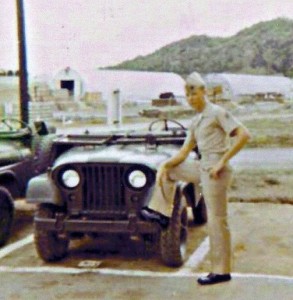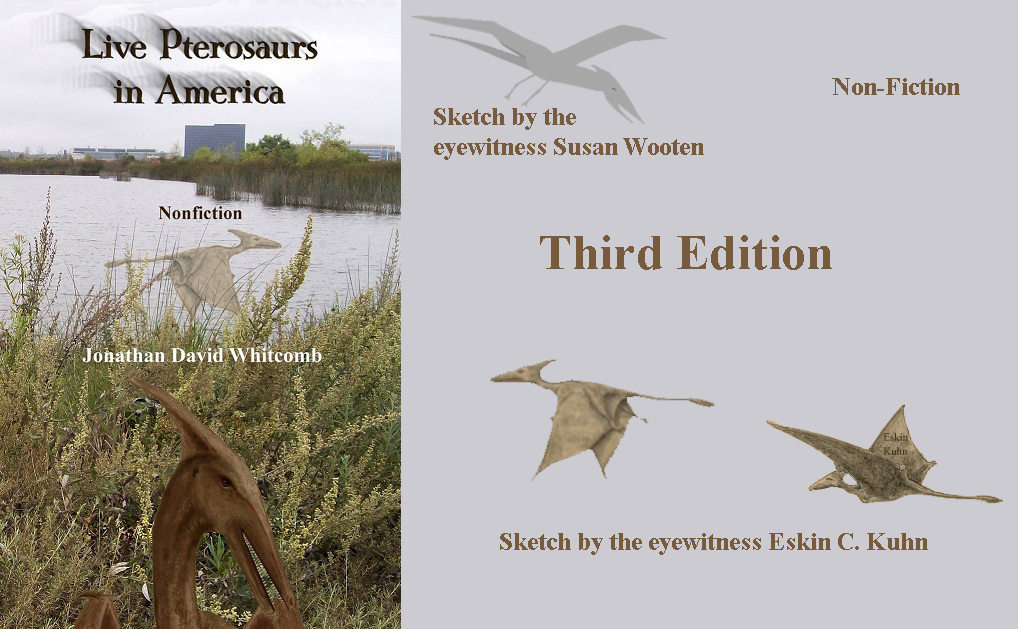Regarding a live “pterodactyl” at the Guantanamo Bay military installation in Cuba, the eyewitness Eskin C. Kuhn has recently sent me a letter that puts his report in clearer perspective.
It was good of you to call and tell me about the woman [Patty Carson], who as a girl of six witnessed a very similar species of pterosaur in so close a proximity to my sighting. I can well imagine that a young girl would have been terrified at such an encounter . . .
I really tried to “cram” my study at that time [his 1971 sighting of two pterosaurs in Cuba], focusing on details as well as taking in the overall form and motion of the pair in flight. I tried to memorize the details that would enable me to commit them to paper in a sketch so as to accurately define the creature. . . . the long strands of hair in a tuft at the end of the tail (a brush, not flesh covered as the rest), and that detail has become muted by the many copies of the drawing, the original newsprint type coarse paper . . .
. . . this morning I turned the corner at the base of my property and headed up the hill and saw a relatively familiar sight . . . a Great Blue Heron in flight. . . . The Heron in flight would make many a person wishing to see a pterosaur think they had. It’s great wings, short body, long heavy beak and crooked neck, prow-like chest and very long legs trailing behind with curved toes resembling a tail . . . it puts you in mind of such creatures as pterosaurs . . . unless you have actually seen pterosaurs. Then the differences are dramatic.
The fellow across the road from me once had the arrogant temerity to tell me that what I had seen in Cuba was a “Frigate” [bird]. He had owned property . . . in the Caribbean and assumed he was therefore expert on all the flora and fauna. What I saw looked nothing close to a frigate. Is it any wonder that more people don’t talk about such things?
 Summary of Kuhn sighting of 1971
Summary of Kuhn sighting of 1971
It was a beautiful, clear summer day . . . I was looking in the direction of the ocean when I saw an incredible sight. It mesmerized me! I saw two pterosaurs (or pterodactyls, what’s in a name?) flying together at low altitude, perhaps 100 feet, very close in range from where I was standing, so that I had a perfectly clear view of them.
The rhythym of their large wings was very graceful, slow; and yet they were flying and not merely gliding . . .

The pterosaurs I saw had the short hind legs attached to the rearwardmost part of the wing, and they had a long tail trailing behind with a tuft of hair at the end. The head was disproportionately large, with a long crest at the back, long bill, long neck with a crook in it. The chest of the creatures was similarly prominent, protruding forward like the prow of an old ship.
Child Eyewitness of a “Pterodactyl” or “Flying Dinosaur” in Cuba
Patty Carson, at about six years old, apparently saw the same species of pterosaur in Cuba as Eskin Kuhn did, only she saw the frightening flying creature six years earlier, in 1965.
. . . sparse scrub vegetation around four feet tall, smelled like tar from the boatyard and sulfer from the sandy flats. There were some stagnant pools here and there, a few inches deep in the area. We were walking through that scrub area, and suddenly it sat up . . . It was at about 2 o’clock [a little to the right of where they were heading] right in front of us about thirty feet away. All of us froze for about five seconds, then it leaned to its left and took off with a fwap fwap fwap sound, in a big hurry, more of a scramble, and flew to its left and disappeared behind trees and terrain.
We went home and I was ALL excited to tell my family I had seen a dinosaur, but they all poo poo’d me and started to tell me it was a pelican or frigate bird. NO WAY! It was as tall as a man when it stood up on it haunches. It was close. It froze for a few seconds so I got a good look.
I know exactly what I saw. . . . [recently] I googled “Pterodactyl in Cuba” and I’ll be DAMNED if that guy’s drawing didn’t come up on the first page, and the word Guantanamo!!! . . . [referring to Eskin Kuhn’s sketch] I looked at his drawing, and if I had to make any changes I would make the tail maybe six inches shorter and the wings maybe 10% longer, maybe even 15%, but the proportions of the head are very good, and the body and the hind legs are exactly as I remember.
[Patty Carson, RN in Southern California, 2011]
Some pterosaurs in North America glow like the ropen of Papua New Guinea. Although the sightings by Carson and Kuhm, in 1965 and 1971, were daylight encounters, those flying creatures may be mostly nocturnal, perhaps even closely related to the ones seen by some eyewitnesses to glow with bioluminescence at night.
In the book Hunting Marfa Lights, by James Bunnell, pages 270-279 contain a table with dozens of ML (mystery light) sightings with much information on dates, times, and weather conditions. The recent excitement on some blogs comes from a recent enlightenment centered on the dates July 14-15, 2006 (Texas time), in particular on the times that those mystery lights first appear each night: Thirty-eight and thirty-seven minutes after sunset respectively. This now seems extremely significant.
_____________________________________________________________________
Nonfiction cryptozoology books on living pterosaurs include Live Pterosaurs in America, now in its third edition. This is the leading seller in this narrow field of nonfictions. In the appendix is recorded more in relation to Kuhn’s sighting in Cuba, many years ago:
Did Abyssal the blogger believe there was no such person as Eskin Kuhn, that not just pterosaurs but the U.S. Marine himself was unreal? Then why include a link to a long web page that contains over 800 words of text, the words of Eskin Kuhn himself? That page also includes photos, including one of Kuhn, on the military base, holding a rifle. For those who have seen that page, belief in that young man’s existence is easy, even if belief in the existence of modern pterosaurs is hard. But still Abyssal apparently doubted Kuhn’s existence, for why else would he (or she) write so little about this account, yet mention that “Eskin Kuhn” was spelled differently on other web pages? It makes the marine seem unreal.



